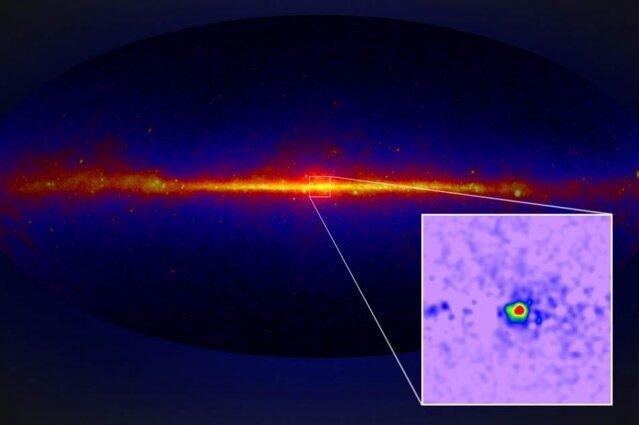A map of gamma ray emissions throughout the Milky Way galaxy, based on observations from the Fermi Gamma-ray Space Telescope. The inset depicts the Galactic Center Excess –- an unexpected, spherical region of gamma ray emissions at the center of our galaxy, of unknown origin. Photo by NASA/T. Linden, U.Chicago
Dec. 12 (UPI) -- New analysis by astrophysicists at the Massachusetts Institute of Technology suggests dark matter could explain a mysterious source of gamma rays in the center of the Milky Way.
Gamma rays are the the most energetic electromagnetic waves. Throughout the Milky Way, astronomers have traced gamma rays to two sources: supernovae and pulsars. But at the center of the Milky Way, scientists have struggled to account for a glow of gamma rays.
Previously, MIT scientists developed simulations suggesting a collection of pulsars, rapidly rotating neutron stars, were responsible for the stream of gamma rays.
More recently, the same team of astrophysicists reexamined their model. The researchers attempted to trick the simulation by supplying it with a false dark matter signal. The model, unable to distinguish between the pulsars and dark matter, produced the same result as before.
The new research, published this week in the journal Physical Review Letters, suggests dark matter is back in play as a viable explanation for the Milky Way center's gamma ray emissions.
"It's exciting in that we thought we had eliminated the possibility that this is dark matter," researcher Tracy Slatyer, an associate professor of physics at MIT, told MIT News. "But now there's a loophole, a systematic error in the claim we made. It reopens the door for the signal to be coming from dark matter."
Most of the Milk Way's matter is situated on a flat plane. The galaxy is shaped like a giant spiral disk. But the gamma rays emanating from the galaxy's center appear more like a giant sphere, pushing out 5,000 light-years in every direction.
The original model developed by Slatyer and her colleagues was designed to determine whether the sphere of gamma rays in the Milky Way's galactic center appeared "smooth" or "grainy."
Because pulsars are so bright, they should produce a grainy appearance, while gamma rays traced to dark matter should yield a smooth sphere.
The model they came up with was tweaked to produce both a smooth and grainy sphere. When scientists supplied the model with data collected by the Fermi telescope, they found the grainy simulation best matched Fermi's observations.
"We saw it was 100 percent grainy, and so we said, 'oh, dark matter can't do that, so it must be something else,'" Slatyer said. "My hope was that this would be just the first of many studies of the galactic center region using similar techniques. But by 2018, the main cross-checks of the method were still the ones we'd done in 2015, which made me pretty nervous that we might have missed something."
Suspecting there was something amiss with their model, Slatyer and MIT postdoc Rebecca Leane began working to undermine it -- to poke holes in it.
Leane and Slatyer decided to rerun the 2015 simulations using fake Fermi data, a fictional map of the sky featuring a made-up dark matter signal. Despite the dark matter signal, the model still spit out a grainy sphere, once again implicating pulsars as the primary source of the gamma rays in the middle of Milky Way.
The researchers decided to run their model again, this time with a fake dark matter signal hidden in real Fermi data. Scientists ran the simulation several times, each time turning up the volume of the fake dark matter signal. The model failed to distinguish between the dark matter and pulsars.
The scientists had indeed found a "mismodeling effect."
"By that stage, I was pretty excited, because I knew the implications were very big -- it meant that the dark matter explanation was back on the table," Leane said.
As usual, the latest findings, while exciting, mean there is a lot more work to do. Slatyer, Leane and their colleagues are once again working to rid their model of its bias and reexamine Fermi's observations of the mysterious glow of gamma rays.
Maybe it's been dark matter producing those gamma rays all along.
"If it's really dark matter, this would be the first evidence of dark matter interacting with visible matter through forces other than gravity," Leane said. "The nature of dark matter is one of the biggest open questions in physics at the moment. Identifying this signal as dark matter may allow us to finally expose the fundamental identity of dark matter. No matter what the excess turns out to be, we will learn something new about the universe."















